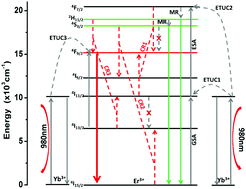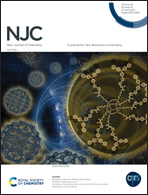Insight into the mechanism of intense NIR-to-red upconversion luminescence in Er3+ doped and Er3+–Yb3+ co-doped SrF2 nanoparticles
Abstract
A succession of erbium single-doped and erbium/ytterbium co-doped SrF2 nanoparticles (NPs) were fabricated via a hydrothermal synthesis technique followed by high-temperature calcination. Structural, morphology, and element information of SrF2 NPs were explored using X-ray diffraction (XRD), scanning electron microscopy (SEM) and energy dispersive X-ray spectroscopy (EDX) instruments. Under near-infrared (NIR) excitation, the SrF2:Er3+ NPs exhibit a prominent red emission peak (at 670 nm) as well as two oppositely faint green emission peaks (at 525 nm and 548 nm). The probable mechanism of the dominant red up-conversion luminescence (UCL) emission was systematically studied by UC emission spectroscopy, Raman spectroscopy, Fourier transform-infrared spectroscopy (FT-IR) and diffuse reflectance spectrum analyses. We used the energy gap law to estimate the probability of electronic transition, which determines the UCL emission route. The behavior of the R/G value (emission intensity of red to green ratio) and the slope n (the number of photons absorbed during the excitation process) reflected the existence of a highly efficient cross-relaxation (CR) effect during the UC process in the SrF2 system, so we can infer that the prominent red UCL emission is due to the CR effect among adjacent erbium atoms. After co-doping with ytterbium ions, the red UCL emission intensity is further enhanced. By comparing 2 mol% Er3+,5 mol% Yb3+ co-doped SrF2 samples with a similar composition without ytterbium doping, a red UCL emission intensity enhancement of about 200 times was observed. This increase is ascribed to the existence of effective energy transfer up-conversion (ETUC) from ytterbium to erbium, and the presence of a large absorption peak of ytterbium in the range of 830–1060 nm was observed in the diffuse reflectance spectrum, indicating that ytterbium's ability to absorb 980 nm photon energy is significantly stronger than erbium's. The strong red radiation obtained for erbium/ytterbium co-doped SrF2 NPs is expected to have potential application prospects in in vivo bio-imaging and photodynamic therapy.



 Please wait while we load your content...
Please wait while we load your content...